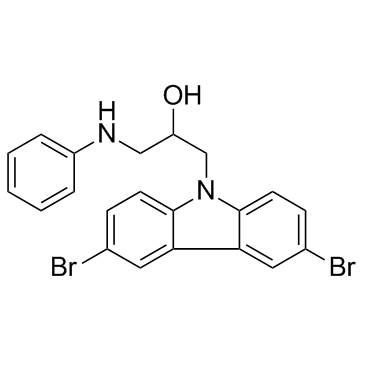P7C3

P7C3 structure
|
Common Name | P7C3 | ||
|---|---|---|---|---|
| CAS Number | 301353-96-8 | Molecular Weight | 474.188 | |
| Density | 1.6±0.1 g/cm3 | Boiling Point | 656.4±55.0 °C at 760 mmHg | |
| Molecular Formula | C21H18Br2N2O | Melting Point | N/A | |
| MSDS | Chinese USA | Flash Point | 350.8±31.5 °C | |
| Symbol |


GHS05, GHS06 |
Signal Word | Danger | |
Use of P7C3P7C3 is a NAMPT activator. P7C3 can enhance learning and memory in aged rats. Protects newborn neurons in the dentate gyrus by mitigating cell death. In vitro: Administration of active P7C3 chemicals to cells treated with doxorubicin, which induces NAD depletion, led to a rebound in intracellular levels of NAD and concomitant protection from doxorubicin-mediated toxicity. In vivo: P7C3 is orally bioavailable, crosses the blood-brain barrier, and is non-toxic at doses several fold higher than the efficacious dose.An easily administered pro-neurogenic compound. The administration of P7C3 is 10mg/ kg( IP) in rats. Administration of P7C3 to normal mice, as well as npas3-/- mice, enhance survival of neurons subsequent to their birth in the SGZ. |
| Name | 1-anilino-3-(3,6-dibromocarbazol-9-yl)propan-2-ol |
|---|---|
| Synonym | More Synonyms |
| Description | P7C3 is a NAMPT activator. P7C3 can enhance learning and memory in aged rats. Protects newborn neurons in the dentate gyrus by mitigating cell death. In vitro: Administration of active P7C3 chemicals to cells treated with doxorubicin, which induces NAD depletion, led to a rebound in intracellular levels of NAD and concomitant protection from doxorubicin-mediated toxicity. In vivo: P7C3 is orally bioavailable, crosses the blood-brain barrier, and is non-toxic at doses several fold higher than the efficacious dose.An easily administered pro-neurogenic compound. The administration of P7C3 is 10mg/ kg( IP) in rats. Administration of P7C3 to normal mice, as well as npas3-/- mice, enhance survival of neurons subsequent to their birth in the SGZ. |
|---|---|
| Related Catalog | |
| References |
| Density | 1.6±0.1 g/cm3 |
|---|---|
| Boiling Point | 656.4±55.0 °C at 760 mmHg |
| Molecular Formula | C21H18Br2N2O |
| Molecular Weight | 474.188 |
| Flash Point | 350.8±31.5 °C |
| Exact Mass | 471.978577 |
| PSA | 37.19000 |
| LogP | 6.60 |
| Appearance of Characters | white solid |
| Vapour Pressure | 0.0±2.1 mmHg at 25°C |
| Index of Refraction | 1.687 |
| Storage condition | -20℃ |
| Symbol |


GHS05, GHS06 |
|---|---|
| Signal Word | Danger |
| Hazard Statements | H301-H318 |
| Precautionary Statements | P280-P301 + P310-P305 + P351 + P338 |
| RIDADR | UN 2811 6.1 / PGIII |
| HS Code | 2933990090 |
| HS Code | 2933990090 |
|---|---|
| Summary | 2933990090. heterocyclic compounds with nitrogen hetero-atom(s) only. VAT:17.0%. Tax rebate rate:13.0%. . MFN tariff:6.5%. General tariff:20.0% |
|
Chronic P7C3 treatment restores hippocampal neurogenesis in the Ts65Dn mouse model of Down Syndrome [Corrected].
Neurosci. Lett. 591 , 86-92, (2015) Down syndrome (DS) is the most common genetic cause of intellectual disability and developmental delay. In addition to cognitive dysfunction, DS patients are marked by diminished neurogenesis, a neuro... |
|
|
Contribution of growth differentiation factor 6-dependent cell survival to early-onset retinal dystrophies.
Hum. Mol. Genet. 22(7) , 1432-42, (2013) Retinal dystrophies are predominantly caused by mutations affecting the visual phototransduction system and cilia, with few genes identified that function to maintain photoreceptor survival. We reason... |
|
|
Neuroprotective efficacy of aminopropyl carbazoles in a mouse model of amyotrophic lateral sclerosis.
Proc. Natl. Acad. Sci. U. S. A. 109(42) , 17016-21, (2012) We previously reported the discovery of P7C3, an aminopropyl carbazole having proneurogenic and neuroprotective properties in newborn neural precursor cells of the hippocampal dentate gyrus. We have f... |
| P7C3 |
| 1-(3,6-Dibromo-carbazol-9-yl)-3-phenylamino-propan-2-ol |
| 1-Anilino-3-(3,6-dibromo-9H-carbazol-9-yl)-2-propanol |
| 9H-Carbazole-9-ethanol, 3,6-dibromo-α-[(phenylamino)methyl]- |
| 1-(3,6-dibromo-9H-carbazol-9-yl)-3-(phenylamino)propan-2-ol |
| 1-Anilino-3-(3,6-dibromo-9H-carbazol-9-yl)propan-2-ol |